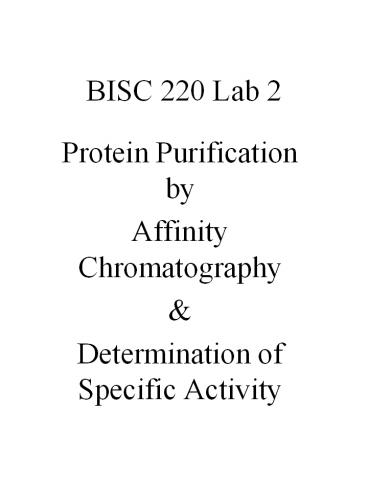BISC 220 Lab 2 - PowerPoint PPT Presentation
Title:
BISC 220 Lab 2
Description:
BISC 220 Lab 2 Protein Purification by Affinity Chromatography & Determination of Specific Activity – PowerPoint PPT presentation
Number of Views:64
Avg rating:3.0/5.0
Title: BISC 220 Lab 2
1
BISC 220 Lab 2
- Protein Purification by
- Affinity Chromatography
- Determination of Specific Activity
2
TO DO TODAY
- Extract protein induced last week from the
bacterial cells - chemical cell lysis withBacterial Protein
Extraction Reagent- DETERGENT - Removal of cell debris by centrifugation
- Partial Purification of protein
- Separate the protein of interest from other
proteins by Affinity Chromatography - Assay the total protein in the CRUDE EXTRACT
the PURIFIED FRACTION and Assay the specific
activity of the b-gal in each. - Quantify compare total protein specific
activity for both fractions then calculate
yield purification factor
3
Affinity Chromatography the General Strategy
Specific binding
Elution (release)
Can use altered pH, salt, competitor molecule for
elution.
Example
4
Protein Purification via Metal Chelate Affinity
Chromatography
The 6xHis tag on the b-gal will bind tightly
to the Ni agarose, which can be separated
from the supernatant by centrifugation.
Other proteins that interact non-specifically
(weakly) with the Ni agarose will be removed
during washes.
The 6xHis b-gal will be eluted (released)
from the beads by competition with imidazole
(a molecule similar to histidine).
5
Imidazole histidine a structural comparison
Imidazole ring
Excess imidazole out- competes 6xHis-b-gal
for binding to Ni agarose
6
?-Gal Partial Purification ProtocolThings to
Remember
- Follow directions carefully
- Know where you are in process
- Mix well, measure carefully dont confuse
reagents - Be careful making dilutions
- End up with 2 fractions to assay
- Crude Extract-CE
- Purified (partially) Fraction- contains
?-galactosidase-PF
7
Determining Total Protein Content
Spectrophotometrically(both CE and PF)
Protein
8
Making a Standard Curve from Absorbance readings
of known BSA concentrations using Linear
Regression
Absorbance
y m x b, where m is the slope b is the y-
intercept. Use the equation generated by Excel
to solve for x (concentration)
Will need to dilute a 1 mg/ml BSA stock to make
0.1, 0.2, 0.4, 0.6 0.8 mg/ml samples (not a
dilution series make 200 µl of each dilution)
9
Measuring the Specific Activity of b-gal
ONPG artificial substrate for b-gal
Specific activity Vmax (maximum velocity)
rate of appearance of product under conditions
of saturating amounts of substrate
(mmol/min/mg protein)
Detect appearance of ONP (product) by
absorbance at 420 nm.
10
What does the Specific Activity tell you?
With greater purification of an enzyme,
total activity yield will decrease but
specific activity will increase.
Purification factor ratio of specific
activities of PF/CE a higher purification
factor means that more of the protein in the
sample is the enzyme of interest.
11
Calculating the Concentration of ONP from A420
Readings of Enzyme Reactions
- C concentration (moles/L)
- A absorbance reading at given wavelength (no
- units)
- e molar extinction coefficient at given l
- (M-1cm-1)
- l spectrophotometer path length (cm)
Must use an amount of enzyme that produces
an amount of product (in a defined reaction
time) that gives an absorbance reading in the
reliable range for the spectrophotometer (0.1-
1.0). Will try several dilutions of CE PF.
12
Making DilutionsV1 x C1V2 x C2
- FOR PROTEIN ASSAY
- 1. BSA stock 1mg/ml
- Working dilutions (want 200µl)
- 0.1, 0.2, 0.4, 0.6, 0.8 mg/ml
- 2. Purified (PF) Crude Extract (CE)
- 15 dilution with Z buffer (want 300 µl)
- FOR ENZYME ASSAY
- 1. Purified Fraction
- Want 250µl each of 1100, 1200, 1400
- 1800 dilutions
- 2. Crude Extract
- Want 250 µl each of 150, 1100, 1200
- 1400 dilutions
- (Use serial dilution strategy for these.)
13
Things to Remember about Assays
- Protein Assay
- Make 2 reagent blanks instead of 1 since using
double beam spectrophotometer- 11 tubes - Mix dilutions well keep on ice
- Timing is not critical
- ?-Gal Assay
- Keep all diluted fractions on ice
- Make 2 reagent blanks instead 1
- Timing IS critical!!!
- You will have a lot of tubes in your ice
bucket. Be VERY careful not to mix things
uplabel well.
14
Before You Leave
- Add glycerol to remaining purified fraction
give to instructor to freeze - Give 3 samples to instructor (properly
labeledsee p. 41) - Clean up your work area
Homework
- Complete calculations answer questions on p. 42
- Dont wait until the last minute to do the
calculations! - When calculating protein concentrations, dont
forget to account for the dilutions. - For other calculations, follow examples on p.
48-50.































